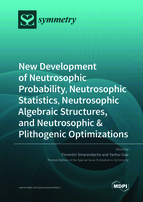New Development of Neutrosophic Probability, Neutrosophic Statistics, Neutrosophic Algebraic Structures, and Neutrosophic & Plithogenic Optimizations
A special issue of Symmetry (ISSN 2073-8994). This special issue belongs to the section "Computer".
Deadline for manuscript submissions: closed (31 December 2021) | Viewed by 48402
Special Issue Editors
Interests: neutrosophic probability; neutrosophic statistics; neutrosophic algebraic structures; plithogenic set; unmatter; superluminal physics; paradoxism; quantum paradoxes
Special Issues, Collections and Topics in MDPI journals
Interests: image processing; medical image processing; pattern recognition; computer vision; data science
Special Issues, Collections and Topics in MDPI journals
Special Issue Information
Dear Colleagues,
This Special Issue invites state-of-the-art papers on new topics related of neutrosophic theories and their applications.
The fields of neutrosophic probability and neutrosophic statistics, neutrosophic algebraic structures, neutrosophic optimization, and neutrosophic applications in symmetry are getting more attention.
Prof. Dr. Florentin Smarandache
Dr. Yanhui Guo
Guest Editors
Manuscript Submission Information
Manuscripts should be submitted online at www.mdpi.com by registering and logging in to this website. Once you are registered, click here to go to the submission form. Manuscripts can be submitted until the deadline. All submissions that pass pre-check are peer-reviewed. Accepted papers will be published continuously in the journal (as soon as accepted) and will be listed together on the special issue website. Research articles, review articles as well as short communications are invited. For planned papers, a title and short abstract (about 100 words) can be sent to the Editorial Office for announcement on this website.
Submitted manuscripts should not have been published previously, nor be under consideration for publication elsewhere (except conference proceedings papers). All manuscripts are thoroughly refereed through a single-blind peer-review process. A guide for authors and other relevant information for submission of manuscripts is available on the Instructions for Authors page. Symmetry is an international peer-reviewed open access monthly journal published by MDPI.
Please visit the Instructions for Authors page before submitting a manuscript. The Article Processing Charge (APC) for publication in this open access journal is 2400 CHF (Swiss Francs). Submitted papers should be well formatted and use good English. Authors may use MDPI's English editing service prior to publication or during author revisions.
Keywords
- Neutrosophic algebraic structures
- Neutrosophic triplet algebraic structures
- Neutrosophic extended triplet algebraic structures
- Neutrosophic algebraic hyperstructures
- Neutrosophic triplet algebraic hyperstructures
- Neutrosophic n-ary algebraic structures
- Neutrosophic n-ary algebraic hyperstructures
- Refined neutrosophic algebraic structures
- Refined neutrosophic algebraic hyperstructures
- Quadruple neutrosophic algebraic structures
- Refined quadruple neutrosophic algebraic structures
- Neutrosophic image processing
- Neutrosophic image classification
- Neutrosophic computer vision
- eutrosophic machine learning
- Neutrosophic Artificial Intelligence
- Neutrosophic data analytics
- Neutrosophic deep learning
- Neutrosophic symmetry
- Applications of neutrosophy







